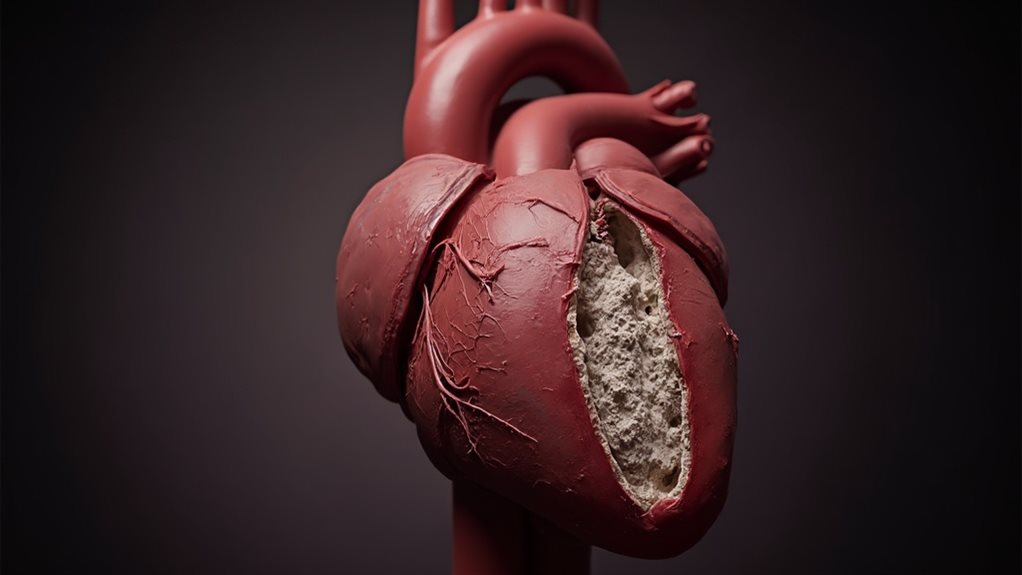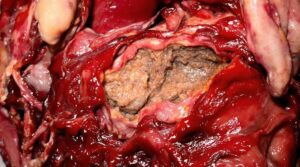
The Widowmaker blockage, a crucial narrowing in the Left Anterior Descending (LAD) artery, greatly jeopardizes heart function by restricting essential blood flow. Key indicators of such a blockage include intense chest pain, radiating discomfort, and sudden breathlessness. Risk factors encompass genetic makeup, lifestyle choices, and underlying health conditions that favor plaque accumulation. Utilizing advanced diagnostic methods like coronary angiography aids in identifying this potentially lethal obstruction. Thorough understanding offers insights into suitable interventions and preventive strategies.
Key Takeaways
- The Widowmaker blockage refers to severe obstruction in the LAD artery, critical for heart muscle oxygenation.
- Symptoms include intense chest pain, breathlessness, and often radiate to arms or jaw.
- High-risk factors include poor lifestyle choices, genetic predisposition, and pre-existing conditions like diabetes.
- Diagnostic methods like coronary angiography and stress tests help detect the severity of blockages.
- Treatments involve angioplasty with stents, bypass surgery, and lifestyle modifications to prevent recurrence.
Understanding the Critical Role of the LAD Artery
The left anterior descending (LAD) artery holds a pivotal role in cardiovascular health, being primarily responsible for supplying oxygen-rich blood to the largest portion of the heart's muscular tissue.
This artery's anatomy features a long course down the front of the heart, branching out to supply the front and main walls of the left ventricle, the heart's primary pumping chamber.
Functionally, the LAD artery's extensive blood supply guarantees adequate oxygenation and nutrient delivery, critical for the sustenance of cardiac muscle activity and overall heart function.
Any compromise in this supply can markedly impact cardiac health.
Recognizing the Signs of a Heart Attack
Recognizing the signs of a heart attack is imperative, as timely intervention can greatly improve survival rates and reduce cardiac damage.
Heart attack symptoms often present as severe chest pain, typically described as a crushing or squeezing sensation. This pain may radiate to the arms, neck, jaw, or back, indicating the spread of cardiac distress.
Additional signs include sudden onset of shortness of breath, sweating, and nausea. These symptoms manifest due to the obstruction of blood flow to the heart muscle, leading to ischemia and potential myocardial infarction if not promptly addressed.
Immediate medical evaluation is critical upon recognizing these signs.
Risk Factors for the Widowmaker Blockage

Understanding the risk factors for the Widowmaker blockage is essential, as it involves the left anterior descending (LAD) artery, a key vessel that supplies a noteworthy portion of the heart with blood.
Genetic predisposition plays a important role; individuals with a family history of coronary artery disease are at increased risk.
Lifestyle choices, including smoking, poor dietary habits, and lack of physical activity, greatly contribute to the development of this lethal blockage.
Additionally, conditions such as hypertension, diabetes, and high cholesterol further exacerbate the risk, promoting atherosclerotic plaque buildup within the LAD artery, thereby increasing the likelihood of a severe cardiac event.
Diagnostic Tools and Techniques
To accurately diagnose a Widowmaker blockage, several advanced diagnostic tools and techniques are employed, each designed to evaluate the integrity and functionality of the left anterior descending (LAD) artery.
Cardiac imaging, including echocardiography and coronary angiography, provides detailed visualizations of the LAD's structure and blood flow.
Stress testing, another pivotal diagnostic method, assesses how well the heart functions under physical exertion, highlighting any abnormalities suggestive of a blockage.
Together, these techniques enable clinicians to detect the presence and severity of a Widowmaker blockage, facilitating timely intervention to prevent catastrophic cardiac events.
Immediate Response and Emergency Procedures

When symptoms of a heart attack indicative of a Widowmaker blockage appear, immediate medical intervention is critical to mitigate the risk of severe cardiac damage or death.
Emergency response protocols emphasize rapid recognition and dispatch of advanced medical support. First aid measures, essential in the interim, include administering aspirin to reduce clot formation and instructing the patient to assume a semi-upright position to alleviate heart strain.
Promptly calling emergency services guarantees timely access to life-saving interventions. Monitoring key signs and preparedness to perform cardiopulmonary resuscitation (CPR) are recommended if the individual becomes unresponsive, maintaining stability until professional help arrives.
Treatment Options for Managing Blockages
Following immediate measures and emergency protocols for addressing heart attack symptoms related to a Widowmaker blockage, attention shifts towards long-term management strategies to prevent further cardiac complications.
The focus on preserving heart function and minimizing risk of recurrence involves several key interventions:
- Angioplasty Techniques: Involves using a balloon catheter to open the narrowed artery, improving blood flow.
- Stent Placement: Often follows angioplasty to provide structural support and keep the artery open.
- Bypass Surgery: Creates alternative pathways for blood, circumventing severely blocked arteries.
- Medication Regimen: Prescribed to prevent clot formation and manage lipid levels.
- Regular Monitoring: Guarantees ongoing assessment and timely intervention.
Lifestyle Changes and Preventive Measures

Although medical interventions such as angioplasty and bypass surgery are critical for managing Widowmaker blockages, adopting extensive lifestyle changes plays a pivotal role in preventing the recurrence of such severe cardiac events.
Incorporating healthy habits and substantial dietary changes substantially mitigates the risks associated with this lethal condition. Regular physical activity, cessation of smoking, and maintaining a balanced diet rich in fruits, vegetables, and whole grains while low in saturated fats and processed sugars can profoundly impact cardiovascular health.
Additionally, routine monitoring of blood pressure and cholesterol levels, combined with stress reduction techniques, further fortify the heart against potential threats.
Frequently Asked Questions
Can Emotional Stress Trigger a Widowmaker Heart Attack?
Emotional stress may precipitate a heart attack by exacerbating underlying cardiovascular conditions. Effective stress management is essential for maintaining heart health and potentially mitigating the risks associated with severe cardiac events.
How Does Sleep Quality Impact Widowmaker Blockage Risks?
Opening Pandora's box, sleep deprivation greatly impacts heart health, increasing risks associated with widowmaker blockages by exacerbating hypertension and stress, thereby accelerating arterial plaque buildup, which can critically impair cardiac function.
Are There Gender Differences in Widowmaker Heart Attack Symptoms?
The inquiry explores whether female and male symptoms of widowmaker heart attacks differ. Evidence indicates women may experience subtler symptoms like nausea, while men often report pronounced chest pain. Detailed symptom recognition aids early intervention.
What Is the Survival Rate After a Widowmaker Heart Attack?
Survival rates after a widowmaker heart attack vary, influenced by immediate treatment and underlying health. Survival statistics hinge on swift, effective recovery strategies, including emergency interventions and rigorous post-event medical monitoring and therapy.
Can Young People Suffer From Widowmaker Blockages?
Yes, young adults can suffer from widowmaker blockages, particularly those with significant lifestyle risk factors such as obesity, smoking, and high cholesterol, despite their age seemingly offering a protective buffer against severe cardiac events.
Conclusion
In confronting the formidable Widowmaker blockage, the stakes could not be higher. An insidious adversary, this blockage clandestinely undermines the heart's essentiality, often culminating in catastrophic cardiac failure. Armed with advanced diagnostic technologies and cutting-edge treatments, the medical community wages a relentless war against this silent killer. Vigilance, coupled with stringent preventive strategies, remains our bulwark against the ceaseless threat posed by this lethal obstruction in the arterial battleground of cardiovascular health.



